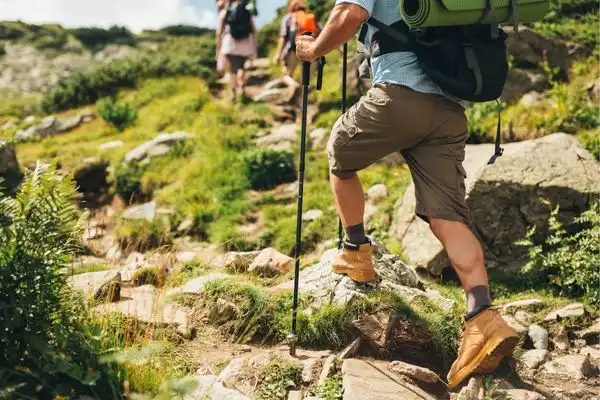West Maui was formed by volcanic eruptions that occurred over 320,000 years ago, and the erosion of the subsequent years has led to deep valleys, rugged peaks, and sharp ridges.
It’s a landscape that is impossible to understand from the outside, which is why West Maui hiking trails are so popular.
Check out our guide to the best West Maui Hikes, and get exploring!

13 Crossings
Table of Contents
Following the Makamakaole Stream until it reaches the Makamakaole Falls, 13 Crossings is the rare waterfall hike on West Maui.
The trail head has a reputation for being difficult to find: follow the Kahekili Highw ay until the bridge over the Makamakaole Stream, and look for a place to park next to the road. The trailhead is right by the bridge.
The trail itself snakes alongside the Makamakaole Stream, taking you back and forth across the water. The trail passes banyan trees and through a small bamboo forest, before finishing at the waterfall.
It’s a one-way trail, so follow the same path home. The trail takes roughly 2 hours, and the hardest parts are the stream crossings.
‘Iao Valley State Monument
The ‘Iao Valley State Monument isn’t much of a hike in the traditional sense, but it is worth mentioning.
Instead of the long and winding trail typical of Maui hikes, the ‘Iao Valley trail is short, easy to follow, and suitable for all ages. It ends at a lookout point that offers excellent views of the ‘Iao Valley, including the iconic ‘Iao Needle.
Visit in the morning to avoid the clouds.
Kapalua Coastal Trail
At 2 miles long, the Kapalua Coastal Trail is an excellent coastal hike with low difficulty and high reward. Starting at Kapalua Bay and following the coast around to D.T. Fleming Beach, the trail passes epic views of Lanai and Molokai.
The trail begins as a paved pathway, which changes to a dirt trail as you move along the coast, before turning to boardwalk, and then back to paving.
Make sure to follow the trail across the rocks to Makaluapuna Point, where you can see the Dragon’s Teeth lava formations.
Lahaina Pali Trail
While many of the West Maui trails pass through the lush greenery, the Lahaina Pali Trail is a little different.
A rocky trail on the drier southern slopes of the West Maui Mountains, the Lahaina Pali Trail is a strenuous hike with a 1,600 feet elevation gain. Either expect a 10-mile round hike, or leave a second car at Ma’alaea, where the 5-mile trail ends.
Passing through meadow pathways and over high ridges, the Pali Trail requires hard work and plenty of water/food.
Part way is a windmill field, which is a good turning point if you want an easier trip.

Kapalua Village Walking Trail
A 4-mile loop walk that starts in Kapalua and takes you into the West Maui mountains, the Kapalua Village Walking Trail is reasonably easy going, although you can expect a bit of a climb.
The trail ends at the Kapalua Duck Pond, which is why you sometimes hear it referred to as the Duck Pond Trail! If you plan on taking the keiki, pack some duck food.
The Village Trail starts at the Kapalua Golf Academy, and diverges into several trail options.
The Cardio Loop is short but intense, the Village Trail is short but relaxing, and the Lake Loop takes you all the way round. Mostly shaded by trees, this is a pleasant trip for a hot morning.
Mahana Ridge Trail
Starting at D.T Fleming Beach, the Mahana Ridge Trail takes hikers into the heart of the West Maui Mountains. At roughly 12 miles there and back, it’s hard work due to the sheer length of the hike.
But the gradual climb is easier on the legs than many Maui hikes, making for a reasonably accessible trail. Once part of a pineapple plantation, keep an eye out for wild pineapples as you walk. It’s a long journey, but the views are spectacular.
The Maunalei Arboretum is a hike on top of a hike, following on from the Mahana Ridge Trail.
This trail, located in the West Maui Mountains, explores the plants left behind by D.T. Fleming, including banyan trees and coffee trees.
Ohai Loop Trail
A 1.2-mile trip, the Ohai Loop Trail is a leg stretch that offers spectacular coastal views. Between the Nakalele Blowhole and the Olivine Pools, the Ohai Loop Trail is suitable for all fitness levels, and the path tends to be quiet.
The trailhead starts near mile marker 41, and is easy to follow.
The Ohai trail is a peaceful loop with attractive vistas and low traffic. Out of the way, pack some snacks and a drink, and be prepared for heavier winds.
Olivine Pools And Nakalele Blowhole
The Olivine Pools and Nakalele Blowhole are both impressive natural wonders formed by the combination of lava rock and crashing waves.
The Nakalele Blowhole is a powerful ocean blowhole, while the Olivine Pools are natural tide pools set into a remote coastal cliff face. Both are only short hikes from their respective trailhead, but as you have to scramble across rocks, these natural landmarks are difficult to get to.
Take care, go slowly, and avoid visiting on damp days. If you visit the blowhole, you must stand back when it erupts!
Waihee Ridge Trail
The views from the Waihee Ridge Trail are next level, as this hike takes you into the West Maui Mountains.
Approximately 5-miles in total, this is a there and back hike with a 1,500-feet elevation gain. It starts off easily, but as you move past the halfway point, you can really feel the climb.
But you understand the gain when you reach the top, and are rewarded with views across the West Maui Mountains and over to the Pacific Ocean. A popular trail, turn off Kahekili Highway and onto Maluhia Road to find decent parking.
The trail is significantly more difficult after wet weather, and sturdy shoes are a must.
Final Thoughts
Hiking in West Maui rewards effort with breathtaking views, although some trails are definitely harder work than others.
Whichever trail you choose, pack plenty of water and snacks, wear sunscreen and strong shoes, and check the weather before you go.
